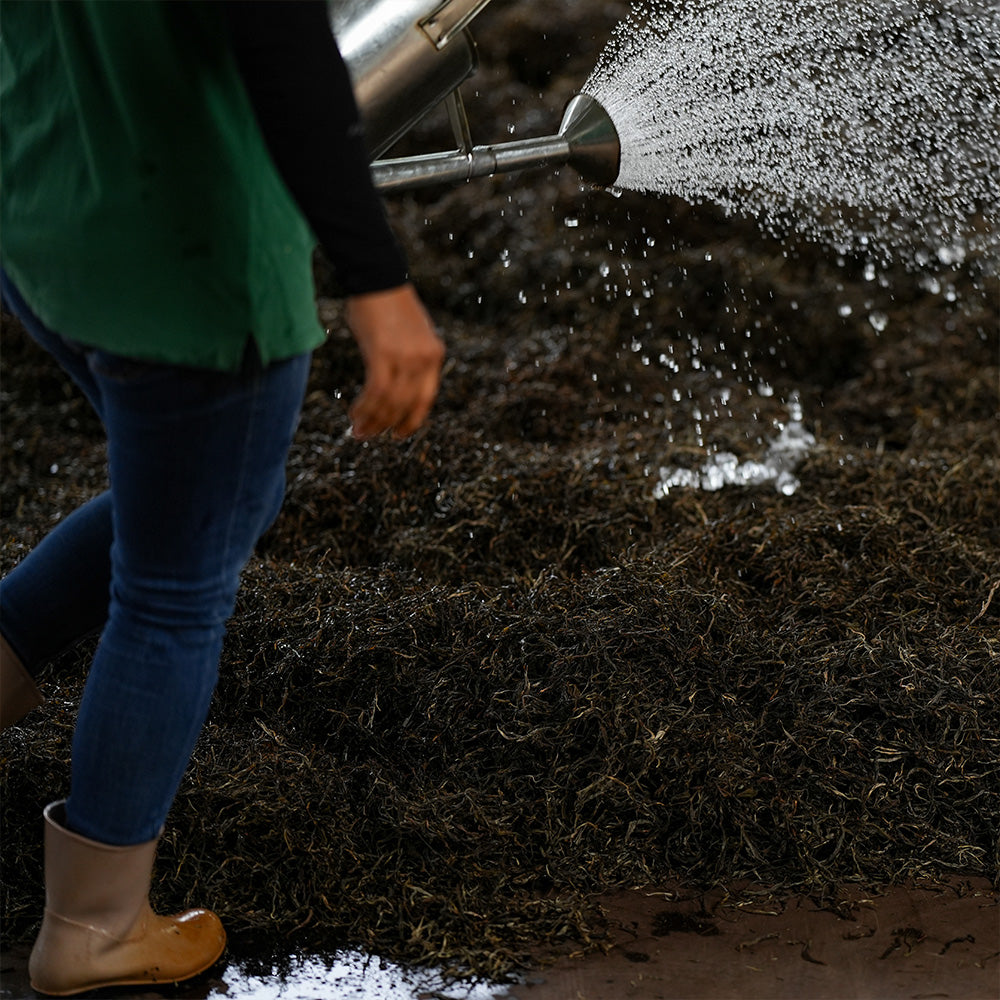Shou Puer tea, also called ripe Puer, is a post-fermented tea from Yunnan province, China. Made using raw Puer tea as the base material, the pile fermentation process transforms this green caterpillar into a magnificent dark butterfly. Or at least that’s how we look at it.
In this guide, you'll learn the history of shou Puer, how it's made, how to find and appreciate high-quality cakes, and more.

A brewed cup of shou Puer tea
How did shou Puer tea come to be?
The earliest productions of shou Puer tea were made in the 1970’s Menghai tea factory in Xishuangbanna in the Yunnan province of China. Though there are instances of other post-fermented teas such as heicha (also called dark tea) that may have been made earlier in other provinces, this is more or less the official accepted story behind shou Puer.
The shou Puer pile fermenting process was made as a way to mimic aged raw Puer. Raw Puer tea is often astringent and bitter when young, whereas many tea drinkers prefer a smooth profile. The pile fermentation process (called wodui) smooths out raw Puer’s inherent astringency and darkens the tea, giving it an easy drinking profile.
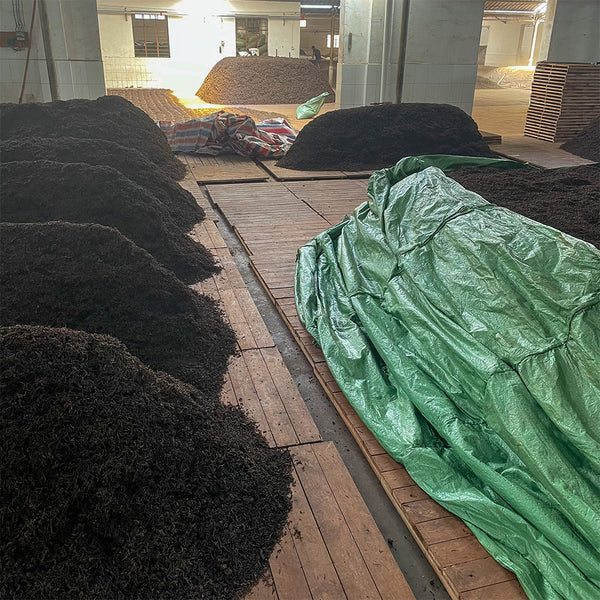
Shou Puer tea piles in various stages of production in Menghai, Yunnan 2023
What is the pile fermentation process?
To make ripe Puer, raw Puer maocha (loose leaf tea) is first piled and sprayed lightly with water. The raw Puer tea pile is then covered with a tarp or canvas cloth where the tea is forced to ferment over a period of between 15-40 days, depending on the tea and desired result. Workers rotate the pile regularly to ensure even fermentation. Over time the microbial activity of the pile turns the green raw Puer tea to a dark shou Puer.
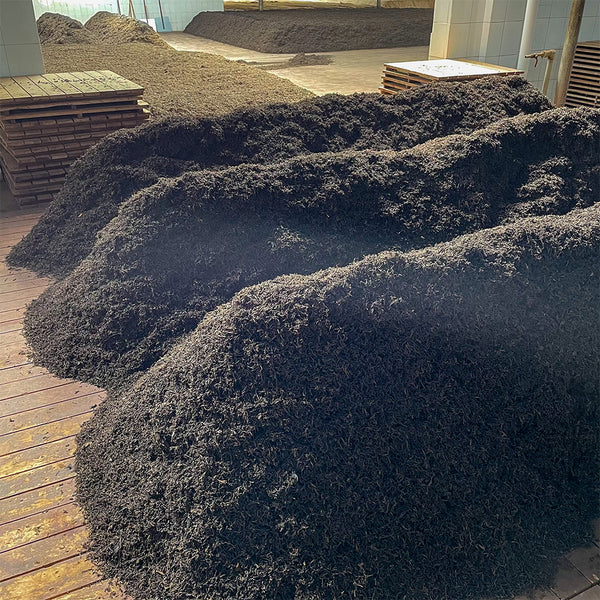
The “kai gou” stage of processing, where the fermented tea is slowly dried in peaked piles
Once the pile fermentation process is completed, the transformed maocha is air-dried in peaked piles , compressed into cakes, and transported to be stored or sold. Contrary to popular belief, shou Puer does benefit from aging, especially when it's on the "greener" (less fermented) side, though all shou tends to improve with at least 3-5 years of aging. Over time, shou Puer improves in flavor and becomes more approachable. Similar to raw Puer, older shou Puer (20+ years old) is prized among collectors and aficionados.
However, there's a catch: a lot of the ripe Puer you'll find on the market is subpar and tends to offer an inferior drinking experience.
How to select high-quality shou Puer
A dark secret of the tea industry is that most shou Puer tea is made on an industrial scale using very low-quality raw Puer tea that is otherwise unsaleable. This “bad raw to bad ripe pipeline” as a way to use leftover tea has damaged the reputation of otherwise deep and interesting tea, though some producers like white2tea and other boutique tea companies are beginning to use higher-quality material in the last decade or so.
The biggest key to discovering your favorite shou Puer is to sample widely. That's the best way to learn which qualities you appreciate (such as particular flavors, mouthfeel and textures, or body sensations).
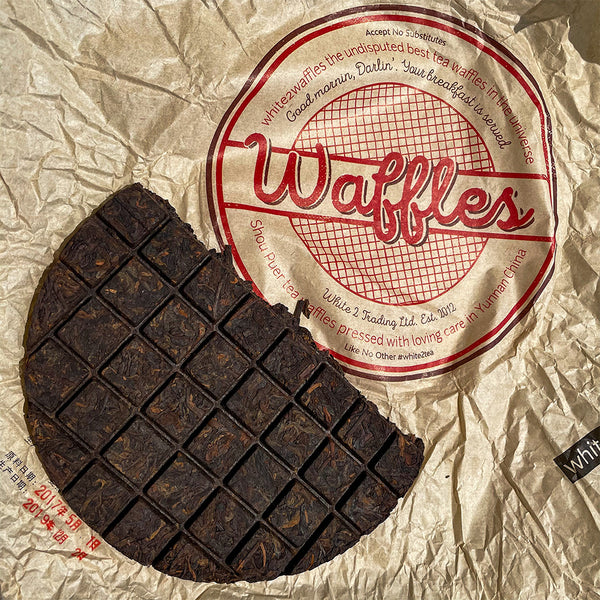
Our Waffles blend, partly named for its sweet flavor and partly for its pressed Waffle shape
For tea lovers who want a sweet introduction to shou Puer tea, Waffles is our standard entry point. For a step up, Old Reliable small batch is a more complex and engaging cup with plenty of sweetness and intrigue. For those seeking a more woody, camphor heavy experience, look to the Lumberslut. If you’d like to jump straight into the deeper end of the pool, Modern Witch is a crowd favorite.
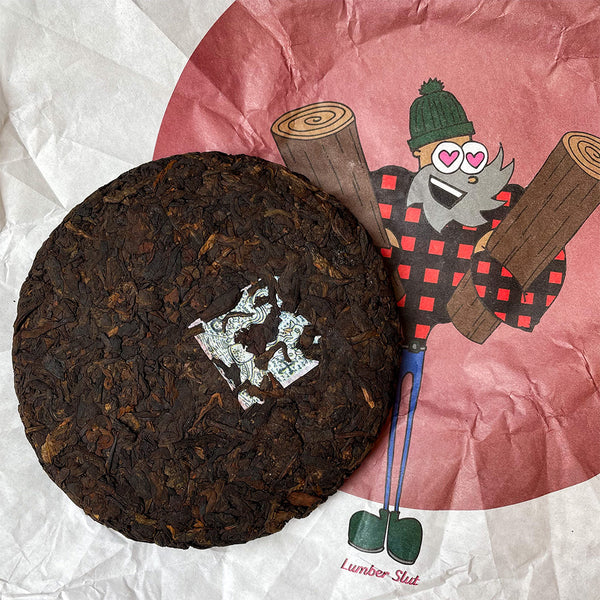
Our woody hero, the Lumber Slut blend, which originally debuted in 2017
When you're shopping around for ripe Puer, we recommend you primarily stick with small-batch cakes. Small batch shou Puer is a nebulous definition across the industry, but at white2tea we use this term to designate piles that are made with a lower quantity of tea. For example, we might ferment a pile using 100 kilograms of high-quality tea, instead of 40 metric tons like some producers.
Due to the historically large size of piles, very few small tea companies make their own shou Puer. Smaller tea companies could rarely afford 40 tons of tea, so they would entrust a large factory to make it and purchase a small amount. This would lead to potential issues as it’s very difficult to truly know what is in the shou Puer tea batch.
The price of ripe Puer
One common misconception is that shou Puer tea costs less than raw Puer due to the historical tendency for large factories to use very low-quality material to make shou. The opposite is in fact true, as the piling process causes a loss of roughly 15% of the total weight of the tea. This means that two identical teas, one raw and one ripe, the ripe would cost at minimum 15% more to make a finished product (which doesn't even count the extra labor costs).
As with any tea, though, the biggest influence on cost comes down to base material. In recent years there is a push to make smaller batches of shou Puer tea using higher-quality leaf material from spring teas and even using more costly old arbor material as a base.
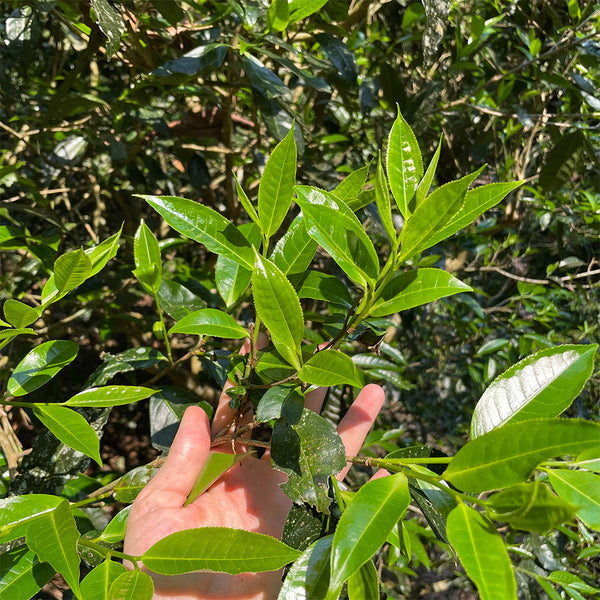
Fresh Puer leaves, the base material for both raw and ripe Puer tea
If you're new to shou, you don't need to spend $100-200 or more for a 200-gram cake (like Nameless One or Lich Tears), though. These teas are made with high-grade materials that experienced drinkers appreciate, but beginners generally don't perceive all their nuances.
The most affordable small batch ripe Puer ranges from about $20 to $50 per 200-gram cake, or 10 to 25 cents per gram. If you use 6 grams of shou in a gaiwan for gongfu style brewing, your tea session will cost $0.60-1.50, which is a great deal — especially considering these teas can usually be re-steeped ten times or more.
Even at the higher end of the shou Puer price range, a gongfu session ends up being around $6-15, which isn't outrageous compared to wine, whiskey, or fine dining. Most of our small batch shous are also available in 7-gram sample sizes, so you can experiment with a variety of them before you commit to a full cake.

A gongfu tea session with our Lumber Slut shou Puer blend
Frequently asked questions about shou Puer
How should I brew ripe Puer tea?
The best way to brew ripe Puer tea is gongfu style, which means multiple, quick steeps using a large amount of leaf in a small vessel. Most people use about 6 grams in a 100 ml gaiwan. Gongfu style provides a totally unique experience that changes with each infusion and, as we mentioned above, can provide ten or more steepings. This is the very best way to appreciate the nuances of Puer tea.
Alternatively, if you're in the mood for an easy session, you can brew your shou Puer tea grandpa style by using much less leaf (around 2 grams, though some people prefer up to 5-7 grams) in a medium or large mug. With this method, you'll repeatedly refill the mug at about the halfway mark with boiling water. You don't need a "grandpa mustache" to filter the leaves — the large Puer leaves will sink down to the bottom and you can sip directly from the top of the mug with no strainer!
It's also acceptable to use a small amount of leaf (3-5 grams) in a large western style teapot or with an infuser basket, using longer steeps of 1-2 minutes or more. If you prepare your tea this way, you'll get around three to five infusions from your teapot or infuser.

A finished pile of shou Puer tea being air dried
Is shou Puer tea easy to brew?
Shou Puer is probably the easiest tea to brew. It is extremely resilient to oversteeping. If you prefer a really heavy, dark brew simply add a few extra grams of tea and steep as long as you please using boiling water.
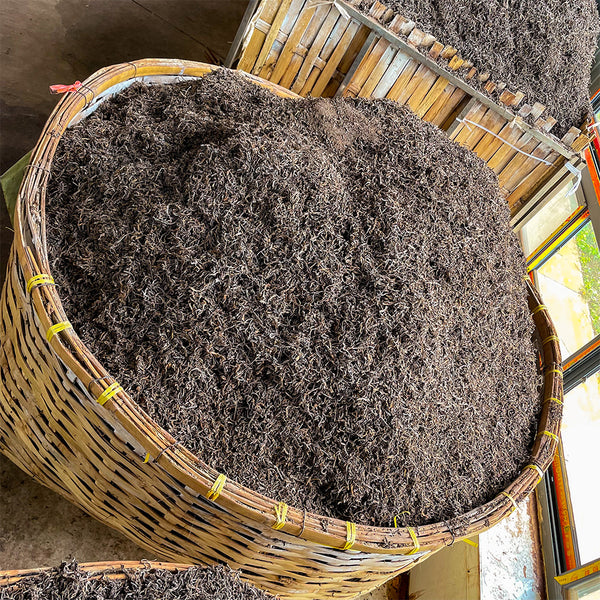
Small batches of Shou Puer being fermented in bamboo baskets in Menghai, 2023
What does shou Puer tea taste like?
Depending on the base material, fermentation, and blending, shou Puer can offer a broad range of flavors and aromas. There are burly teas with woody, forest floor, petrichor and camphor. There are also sweet, fruity teas with notes of vanilla and maple syrup. There are even a few outliers with intense bitterness, though they are much less common.
What are the health benefits of shou Puer tea?
We are always skittish about mentioning health benefits, as teas can never be a panacea or substitute for healthy living, proper diet, exercise, or a good sleep schedule. With that being said, shou Puer tea is a very soothing tea that many people feel helps aid in digestion and calms a turbulent stomach.
Is shou Puer a good substitute for coffee?
For coffee drinkers who are seeking to ditch the bean and embrace the leaf, shou Puer is an ideal substitute. If you add a few extra grams and oversteep a bit you will end up with a cup of thick, rich and dark tea that has a bit of caffeine (albeit not as much as coffee) that is also more soothing to drink — though you could still add cream if you want, the tea police won’t arrest you.
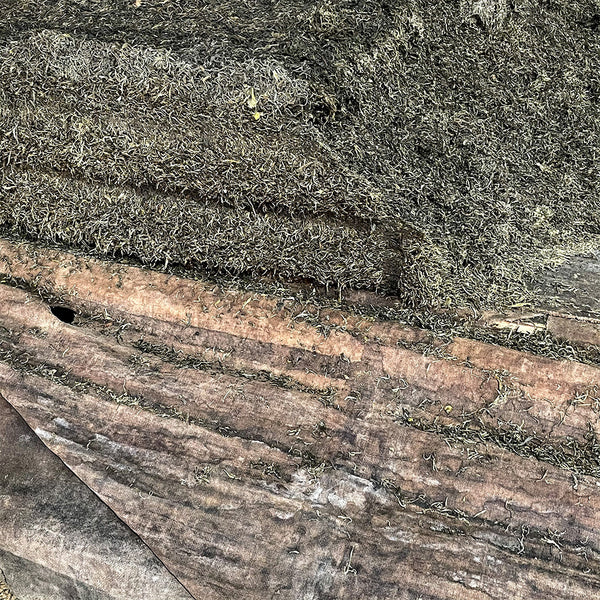
Puer tea as it being piled fermented, the source of the funky flavors
Do people enjoy drinking fresh shou Puer?
Freshly-made shou Puer tea often has what’s referred to as “pile flavor” (also called duiwei) which can be fishy, funky, and unpleasant. Though a small handful of people might like this flavor, it is generally reviled. The good news is that this flavor dissipates with aging. Additionally, white2tea ages our shou Puer before release, so it’s very unlikely that our teas will have pile flavor upon purchase.
Is aging important for shou Puer?
Contrary to a common narrative, shou Puer tea does age and does improve with age. Especially in the first 3-5 years, a shou Puer will have improved clarity as the residual moisture from the piling and pressing process disappears. Shou Puer teas with very light fermentation also have plenty of room to age.

Lightly fermented shou Puer tea cakes, notice their lighter color
What are the different levels of fermentation in ripe Puer?
While there is no standard to describe the levels of fermentation, generally most shou Puer is very heavily fermented (think dark soy sauce). This is the easiest way to ferment tea and also the easiest way to mask flaws from flawed material. There is a trend in recent years from small producers to make lighter fermentation teas which have more depth and complexity.
Here are some good examples of teas using lighter fermentation:
You can think of lightly-fermented shou as being a little bit closer to raw Puer on the spectrum of fermentation. Lighter fermentation levels mean that the original raw characteristics are left intact, leaving a deeper amount of complexity at the sacrifice of some smoothness in the short term. With aging in the proper environment, that sharpness can be tempered, hence the reason why it’s desirable to age lighter fermented shou Puer; you can have the best of both worlds with complexity and smoothness, if you don’t mind waiting a decade (or buying aged tea).

